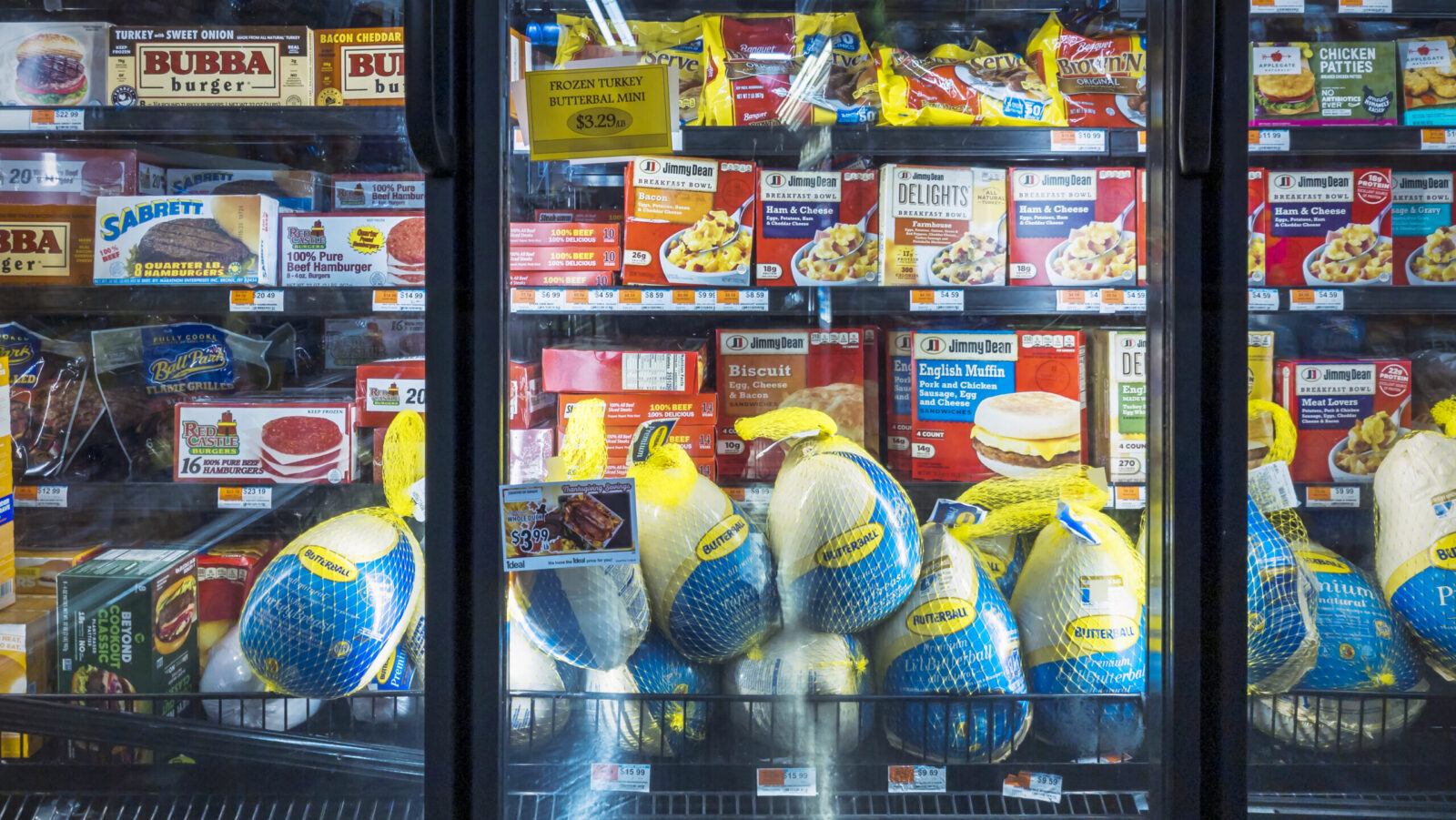Good morning.
The United States Mint pressed its last penny on Wednesday, bringing an end to a 238-year-old tradition. Officially known as the cent (penny comes from the British colloquialism for one pence) it has been the smallest physical unit of American currency since the half-cent was discontinued in 1857.
Beginning in 1909, the penny was minted with a profile of Abraham Lincoln, which made him the first president to appear on US coinage. The famously thrifty Lincoln would likely approve of the coin’s demise: For years, inflation and raw material prices have meant producing a penny costs more than the coin’s face value. Last year, one coin cost three cents to mint. Meanwhile, Lincoln remains on the comparatively lavish $5 bill, which costs 5.3 cents to produce. An honest trade for an honest Abe.
*Presented by Global X. Stock data as of market close on November 12, 2025.
The Global X Artificial Intelligence & Technology ETF (AIQ).
Butterball Battle Begins for Retailers Rolling Out Holiday Deals

Retailers duking it out over shoppers’ shrinking budgets are offering a flurry of holiday deals amid stubborn inflation and volatile tariffs.
Target said this week it’ll slash prices on 3,000 items starting this month through December. The bullseye-branded retailer said this week it’ll shave cents and dollars off the sticker prices of holiday staples like pie crusts, apples and hickory-smoked hams. And for the aftermath of serving as a human jungle gym for little nephews and nieces, there will also be discounts on cold and flu meds. Walmart, meanwhile, quietly rolled out 7,400 price cuts in the summer quarter, 2,000 more than during the same time last year.
With Thanksgiving around the corner, retailers are fighting turkey to turkey: Target said its meal kit for four will cost less than $20 this year before tax, or about $5 a person. Kroger and Aldi’s bundles are similarly priced, while Walmart’s, which includes more than double the feast, rings in at about $40.
Down on Your Potluck
Shoppers are still expected to spend a sizable sum this holiday season, with the National Retail Federation predicting that total spending will increase by about 4% over last year to more than $1 trillion. Deloitte predicts spending will reach as high as $1.6 trillion as consumers refuse to let economic malaise hinder their holidays.
However, analysts and retailers are heading into the season with caution as shoppers are expected to seek out deals to stretch their budgets as much as they can:
- Nearly nine in ten consumers told Numerator they’re worried about how tariffs will affect their finances, with 82% saying they plan to change the way they shop in reaction to the policies. So they’ll be skipping nonessentials, searching for coupons to clip and trading down to discount stores. Consumers could have more to spend than they expected, though: Treasury Secretary Scott Bessent said yesterday that he expects the US to lower tariffs on everyday staples like coffee and bananas sometime this week.
- At the same time, lapsed SNAP benefits could make lower-income consumers come up short on their food-shopping budgets. Walmart’s CEO has noted that lower-income shoppers are becoming more selective in their spending.
The Rest Isn’t Gravy: Cutting the price of Kraft Mac & Cheese can attract shoppers in the short term, but it could also erode future profitability as retailers absorb the cost of deals. And while holiday revelers may prioritize having a feast, analysts warn they could pull back spending on discretionary gifts like appliances and home goods, items with higher margins than boxed mashed potatoes. As retailers battle over Butterballs and PlayStation 5s, investors will be looking for their updated holiday predictions when Target and Walmart report earnings next week.
Why Some Accountants Never Make It To The C-Suite
You have a gift for numbers and the talent of seeing how balance-sheet details sharpen the big picture. But when the brass starts making calls, you’re not even in the room.
That’s a problem you can fix with just a little help from Ramp. The difference between accountants who get stuck and those who rise? It’s down to learning how to position your insights so top execs rely on you.
This on-demand webinar shows you exactly how to:
- Build forecasts that shape strategy.
- Turn data into recommendations nobody can afford to ignore.
- Become the person they call before making major moves.
It’s On: Upstart Swiss Athletics Brand Outshines Rivals by Treating Sneakers Like Birkin Bags
Swiss sneaker brand On is off to the races. Much of the competition is busy trying to tie their shoelaces.
The upstart sportswear firm raised its full-year guidance for the third straight quarter on Wednesday and reported double-digit growth in defiance of struggles at other sneaker firms. What sets it apart? For one, it’s playing a totally different marketing game than its rivals.
Turning On the Swiss Charm
In September, the world’s largest sneaker company, Nike, said it expected sales in its current quarter to fall by a low single-digit percentage. The Oregon-based giant, whose shares are down 15% this year, is in the midst of a turnaround effort that executives have cautioned will take time. Bloated inventory and tariff charges of up to $1.5 billion this year are among the factors weighing down the iconic swoosh.
Deckers, meanwhile, also advised last month that sales of Hoka, its own upstart rival to On, will grow by a percentage in the low teens in fiscal 2026, down markedly from 24% a year earlier. Decker shares are down 58% this year.
Shares in On, which have declined 24% this year, have faced their own struggles. Wednesday, however, they surged 18% on the company’s latest results. Sales rose 25% year-over-year to 794 million Swiss francs ($995 million). Net income of CHF 142 million ($178 million) was nearly triple the CHF 50 million ($63 million) from a year earlier. The Zurich-based company said it expects to keep it up, offering a 2025 net sales guidance of CHF 2.98 billion ($3.76 billion), up from CHF 2.91 billion. Behind their confidence is a luxury-fied Swiss twist:
- On’s shoes are available in stores next to Nike’s, but the company markets them like Swiss luxury goods. Its Cloudmonster running shoe line starts at $170, and executives have openly talked of raising prices so they can keep investing in new technology and lightweight designs to offer high-end products to high-income, high-loyalty customers.
- The investments have paid off, as On has become popular with influencers and athletes. Distance runner Geordie Beamish, hurdler Ditaji Kambundji and sprinter Isabell Whittaker won the company’s first-ever World Athletics Championships gold medals in Tokyo this year, while Kenya’s Hellen Obiri smashed the 22-year-old women’s record in the New York Marathon in a pair of the company’s Cloudboom Strike LS sneakers.
Committed to the Bit: While other shoemakers and retailers will likely roll out their usual seasonal discounts to fuel sales around the holidays, On says you can expect nothing of the sort from them. Not even on Black Friday.

The CFO’s Guide to AI And Machine Learning. We’re only beginning to understand the ramifications of AI, both good and bad. NetSuite surveyed CFOs to learn where they think AI fits in a finance practice. Hear how various AI and machine learning systems function and how you can harness them for business benefit. Read the guide.
Russell 2000’s Good Fortune May Prove to Be a Bad Omen
They may be small caps, but the stakes are hardly small potatoes.
Over the last 100 days, the Russell 2000 has outperformed its rival, the S&P SmallCap 600, by 9%, marking the widest gap since 2010, according to a DataTrek Research note to clients cited by independent financial journalist Phil Rosen. Sure, you might be asking: Who cares? Who even invests in the S&P 600? How does this matter to me? Reasonable questions, of course. Unfortunately, experts say the gap could have widespread implications and is likely yet more evidence of (you guessed it) a bubble.
Frothy The Snowman
The Russell isn’t just outperforming its small-cap peer, it’s on one of its greatest runs of all time, crossing 2,500 for the first time just a month ago. In the past six months, the index has gained roughly 17%, on par with the megacap-driven, AI-supercharged S&P 500. The S&P 600, by comparison, has risen roughly 11% in the past six months. So what sets them apart? Entrance to the Russell 2000 is determined by market cap, whereas the S&P’s small-cap index requires firms to actually turn a profit before admittance.
Historically, the difference has separated the small-cap wheat from the chaff, so to speak, which is why some see the current deviation as overly speculative:
- Between the 600’s launch in 1994 and April’s Liberation Day earthquake, the profit-requiring index had outperformed the Russell by roughly 580%, according to an analysis in The Wall Street Journal.
- Meanwhile, 40% of the Russell companies are unprofitable compared with 22% on the S&P 600, and the Russell’s price-to-earnings ratio is twice as high as its counterpart, Eric Cinnamond, co-founder of small-cap value specialist Palm Valley Capital Management, told the WSJ.
Spirited Debate: “The Russell 2000’s recent wide outperformance versus the S&P 600 is, historically speaking, not so much a sign that it’s time to rotate into the latter as it is a signal that animal spirits are especially elevated,” DataTrek analysts wrote in their note. Cinnamond put it a little more bluntly, telling the WSJ: “Part of the reason the Russell’s doing so well is speculation and greed.”
Extra Upside
- Sp-oiler Alert: Peak oil, the point at which oil demand reaches its all-time high, could now happen as far into the future as 2050, according to the International Energy Agency.
- Breach of Trust: Proxy advisors Glass Lewis and ISS are facing FTC antitrust investigations focused on their advice to shareholder clients on proposals that touch on contentious issues like climate change.
- Skip The Stereotypes. With the right plan, retirement can be whatever you want: road trips, cooking classes or finally writing that novel. Help make your money match your vision with a free retirement review from Edelman Financial Engines. Claim it now.*
* Partner

